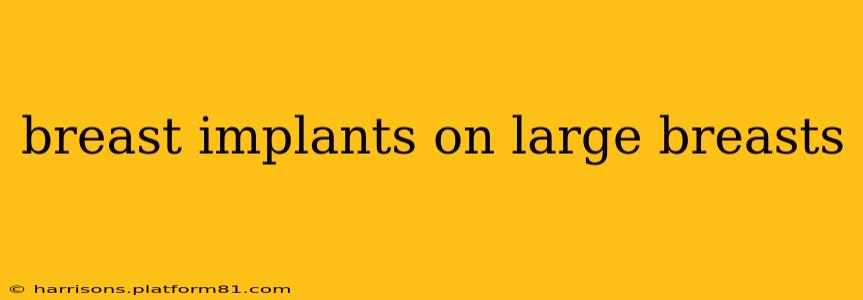Many women with naturally large breasts consider breast implant surgery, but for different reasons than those with smaller breasts. While some might seek augmentation for further enhancement, others opt for reduction mammaplasty (breast reduction) combined with implants for a more manageable size and improved shape. This article explores the complexities of breast implant surgery for women with larger chests, addressing common questions and concerns.
Why Would Someone with Large Breasts Get Breast Implants?
This is a key question because the motivations differ significantly from those seeking augmentation with smaller breasts. Women with already large breasts may choose implants for several reasons:
-
Breast Lift (Mastopexy): Gravity and natural changes can cause significant sagging in large breasts. Implants, often combined with a breast lift, can restore lift and improve the overall shape, providing a more youthful appearance. The implants can provide support and volume to counteract the effects of gravity.
-
Breast Reduction with Augmentation: Very large breasts can cause significant physical discomfort, including back pain, neck pain, and shoulder grooves. A breast reduction surgery removes excess breast tissue, fat, and skin. In some cases, implants are then placed to provide a more natural-looking, aesthetically pleasing shape and volume after the reduction. This is a nuanced procedure, requiring a skilled surgeon to achieve optimal results.
-
Improve Breast Shape and Symmetry: Even naturally large breasts may lack symmetry or have irregularities in shape. Implants can be strategically placed to address these imperfections and create a more balanced and aesthetically pleasing appearance.
What are the Risks and Complications of Breast Implants on Large Breasts?
The risks associated with breast implant surgery are generally similar regardless of breast size, but some factors are amplified with larger breasts:
-
Increased Scarring: Larger breasts often require more extensive incisions, potentially resulting in more noticeable scarring. However, skilled surgeons use techniques to minimize visible scarring.
-
Higher Risk of Capsular Contracture: Capsular contracture, where scar tissue around the implant tightens, causing firmness or pain, may be slightly more common in larger breasts due to increased tension on the implant.
-
Implant Malposition: In some cases, the implant may shift or rotate after placement, particularly in larger breasts, which may necessitate revision surgery.
-
Longer Recovery Time: Recovery may be slightly longer due to the larger volume and manipulation involved in the surgery.
Are There Different Types of Implants Suitable for Larger Breasts?
Yes, the type of implant chosen depends heavily on individual anatomy and desired results. The surgeon will consider factors like breast tissue density and the patient's overall body structure. Generally, textured implants are often favored for larger breasts because they tend to have a lower risk of capsular contracture compared to smooth implants. The choice of implant fill (silicone gel or saline) is also individualized, based on patient preference and the surgeon's assessment.
How Much Does Breast Implant Surgery Cost for Large Breasts?
The cost of breast implant surgery varies greatly depending on several factors, including the surgeon's fees, anesthesia costs, facility fees, and the type of implants used. The complexity of surgery for larger breasts, potentially including a breast lift or reduction, may result in a higher overall cost. It is crucial to discuss all costs upfront with the surgeon before scheduling any procedure.
What is the Recovery Process Like After Breast Implant Surgery on Large Breasts?
Similar to other breast implant procedures, recovery involves some discomfort and limitations. Expect some pain, bruising, and swelling, which is generally managed with medication. A supportive bra will be necessary for several weeks. The complete recovery time varies, but it's typically longer for larger breasts due to the extensive nature of the surgery, possibly taking several months for complete healing and optimal results. Follow-up appointments with the surgeon are essential for monitoring healing and addressing any concerns.
Can I Breastfeed After Getting Breast Implants?
This is a critical question for women who plan to breastfeed in the future. Breast implants themselves do not directly interfere with breastfeeding. However, the incisions made during the surgery could potentially affect milk ducts, though this is less common. This should be thoroughly discussed with your surgeon before the procedure.
Remember, this information is for general knowledge and should not be considered medical advice. Always consult with a qualified and experienced plastic surgeon to determine if breast implant surgery is appropriate for your individual circumstances and to discuss the risks and benefits in detail. Choosing a board-certified surgeon is essential to ensure your safety and optimal results.
